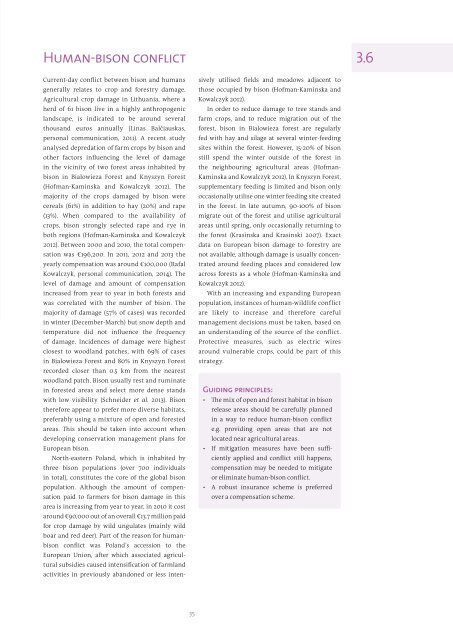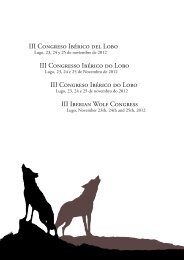Bison-Rewilding-Plan-2014
Bison-Rewilding-Plan-2014
Bison-Rewilding-Plan-2014
- No tags were found...
You also want an ePaper? Increase the reach of your titles
YUMPU automatically turns print PDFs into web optimized ePapers that Google loves.
Human-bison conflict3.6Current-day conflict between bison and humansgenerally relates to crop and forestry damage.Agricultural crop damage in Lithuania, where aherd of 61 bison live in a highly anthropogeniclandscape, is indicated to be around severalthousand euros annually (Linas Balčiauskas,personal communication, 2011). A recent studyanalysed depredation of farm crops by bison andother factors influencing the level of damagein the vicinity of two forest areas inhabited bybison in Bialowieza Forest and Knyszyn Forest(Hofman-Kaminska and Kowalczyk 2012). Themajority of the crops damaged by bison werecereals (61%) in addition to hay (20%) and rape(13%). When compared to the availability ofcrops, bison strongly selected rape and rye inboth regions (Hofman-Kaminska and Kowalczyk2012). Between 2000 and 2010, the total compensationwas €196,200. In 2011, 2012 and 2013 theyearly compensation was around €100,000 (RafalKowalczyk, personal communication, <strong>2014</strong>). Thelevel of damage and amount of compensationincreased from year to year in both forests andwas correlated with the number of bison. Themajority of damage (57% of cases) was recordedin winter (December-March) but snow depth andtemperature did not influence the frequencyof damage. Incidences of damage were highestclosest to woodland patches, with 69% of casesin Bialowieza Forest and 80% in Knyszyn Forestrecorded closer than 0.5 km from the nearestwoodland patch. <strong>Bison</strong> usually rest and ruminatein forested areas and select more dense standswith low visibility (Schneider et al. 2013). <strong>Bison</strong>therefore appear to prefer more diverse habitats,preferably using a mixture of open and forestedareas. This should be taken into account whendeveloping conservation management plans forEuropean bison.North-eastern Poland, which is inhabited bythree bison populations (over 700 individualsin total), constitutes the core of the global bisonpopulation. Although the amount of compensationpaid to farmers for bison damage in thisarea is increasing from year to year, in 2010 it costaround €90,000 out of an overall €13.7 million paidfor crop damage by wild ungulates (mainly wildboar and red deer). Part of the reason for humanbisonconflict was Poland’s accession to theEuropean Union, after which associated agriculturalsubsidies caused intensification of farmlandactivities in previously abandoned or less intensivelyutilised fields and meadows adjacent tothose occupied by bison (Hofman-Kaminska andKowalczyk 2012).In order to reduce damage to tree stands andfarm crops, and to reduce migration out of theforest, bison in Bialowieza forest are regularlyfed with hay and silage at several winter-feedingsites within the forest. However, 15-20% of bisonstill spend the winter outside of the forest inthe neighbouring agricultural areas (Hofman-Kaminska and Kowalczyk 2012). In Knyszyn Forest,supplementary feeding is limited and bison onlyoccasionally utilise one winter feeding site createdin the forest. In late autumn, 90-100% of bisonmigrate out of the forest and utilise agriculturalareas until spring, only occasionally returning tothe forest (Krasinska and Krasinski 2007). Exactdata on European bison damage to forestry arenot available, although damage is usually concentratedaround feeding places and considered lowacross forests as a whole (Hofman-Kaminska andKowalczyk 2012).With an increasing and expanding Europeanpopulation, instances of human-wildlife conflictare likely to increase and therefore carefulmanagement decisions must be taken, based onan understanding of the source of the conflict.Protective measures, such as electric wiresaround vulnerable crops, could be part of thisstrategy.Guiding principles:• The mix of open and forest habitat in bisonrelease areas should be carefully plannedin a way to reduce human-bison conflicte.g. providing open areas that are notlocated near agricultural areas.• If mitigation measures have been sufficientlyapplied and conflict still happens,compensation may be needed to mitigateor eliminate human-bison conflict.• A robust insurance scheme is preferredover a compensation scheme.35



